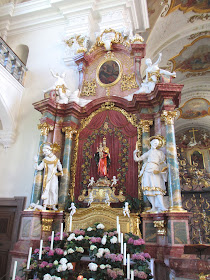St. Peter in the Black Forest is the almost unbelievable name
of a beautiful small village in the rolling hills of the Black Forest (or
Schwarzwald) in southeastern Germany.
In looking up the information for this
post, it took me a while to realize that St. Peter in the Black Forest was not
the name of the abbey with a description of where it was, but actually the name
of the village. With a village by that name, you can get by with the simple
name of “abbey” for the abbey. Without knowing more, I can guess that the name
of the abbey was St. Peter, which existed before the village, and the village
later took on the name of the abbey. It is mind blowing to learn that this abbey
first started in 1073, if not earlier, more than four centuries before Columbus
discovered the new world and about seven centuries before the Spanish built
their missions in California. However, what really gives the current abbey
church its appeal dates back to the 1720s when the two towers on the façade
were built
and the interior was decorated in rococo.
I have only seen a few
rococo churches and I love them. I love the pure white,
which makes the
beautiful reds, pinks, light blues and gold stand out by contrast.
I go inside
and I just want to smile: it is so whimsical and fun.
It makes me happy. Franz
Joseph Spiegler did 55 frescoes dominated by scenes from the life of St. Peter.
St. Peter is depicted in the frescoes
with a gold tunic and a light blue robe.
Joseph Anton Feuchtmayer did the
sculptures. Most of the sculptures are white with gold trim.
I don’t know if
Spiegler and Feuchtmayer coordinated on their depictions, but the sculpture of
St. Peter in the center of the façade, identifiable by the ubiquitous keys, has
a face and hair like the frescoes: a beard and mustache and a balding top with
generous amounts of side and back hair.
After the brightly painted frescoes,
the most eye catching decorations are the outlandish marble, particularly the
reds, pinks and light blues.
As I look at my pictures, I realize that it must
be painted marble.
We have some reddish/pink marble in our home that looks
somewhat like some in the church, but the uniformity of the veining between
pieces, particularly the yellowish gold, looks too suspicious to be real.
The
church does not stand alone, but is built into a structure that covers about a city
block,
which I am guessing was the abbey.
It also appears that it may have been surrounded by a wall at one point.
Right next door is a beautiful, well-kept cemetery, that I wish I could have
spent more time in. The grave stones are in great condition and are surrounded
by colorful flowers.
The monastery has been there since 1090, over 920 years,
when Duke Berthold II of Zahringen established the existing monastery in Hirsau
as a family monastery and then moved it to its current location. In its
apparently short existence prior to that, it was moved to Hirsau from Weilheim
because of military action during the Investiture Controversy. It developed as
a reformed Benedictine monastery answerable to the pope. The Zahringen family
were the initial lord protectors, until about 1218, when their main line became
extinct. This particular property was given to the Counts of Urach, who had
married into the Zahringen family. The monks were not happy with them and
sought protection from Emperor Charles IV. In 1526, the Hapsburgs, who also
inherited other properties passed down from the Zahringen family, assumed the
duty of protectors. In 1806, the monastery was disestablished and given to the
village.
St. Peter being crucified upside down on a cross.






















I absolutely love the riot of color--such a change from the gloomy gothic cathedrals. This is a much more approachable God--one who suffers but who also smiles and laughs.
ReplyDelete